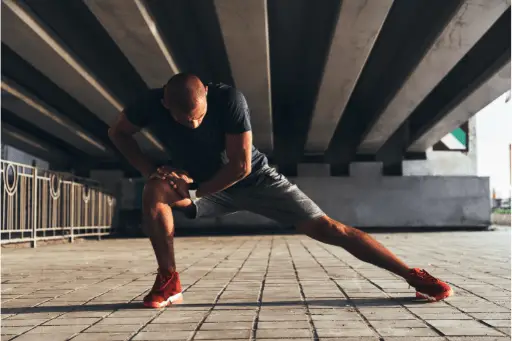This is a common misconception that stretching before a workout is not essential. But in reality, stretching is a crucial part of any workout or exercise program as it improves flexibility and range of motion. On a regular basis, it can also help improve your muscle strength and lower the risk of injury.
In this blog, I will be sharing six reasons on why stretching is important before a workout and what steps you can take to stretch safely.
Also read: 8 Benefits of Stretching in the Morning
Stretching basics
There are mainly two types of stretching: static and dynamic. It is important that you must understand these techniques of stretching.
In static stretching, you hold your stretch for 10 to 30 seconds. Static stretching is an effective way to improve your flexibility. This stretching is mainly used in a part of the cool-down routine.
In dynamic stretching, you don’t hold your stretch but move you targeted muscles and joints through the range of motions 10 to 12 time. Dynamic stretching improves speed and helps in decreasing muscles stiffness. This stretching is mainly used in a part of the warm-up routine.
Why stretching is important before a workout?

1. Reduces the risk of injury
Most people and several authors agree that stretching improves muscles flexibility, which leads to better performance and less chance of injuries.
However, on the other hand, clinical evidence has been reported that stretching before a workout does not prevent injuries. There is no scientifically based prescription or statements about the relationship between stretching and injuries.
According to several other studies, stretching reduces the ability of muscles to perform high-intensity tasks, such as sprinting or jumping. It reduces muscle power in the short term, so if you feel like your performance is reducing while running or jumping, you should perform it after the workout.
Stretching does not eliminate the injuries, but it may reduce the chances of injury. However, if you are stretching before a workout, you must include dynamic stretches or pre-workout stretches in your routine.
2. Increases the muscle strength
Every muscle, organ, and blood vessel in your body is enclosed in a thin layer of connective tissue called fascia. Fascia is necessary to keep your muscles in proper positions. Also, your fascia, on the other hand, maybe preventing the growth of your muscles.
Because fascia is tough, so it usually doesn’t allow your muscles to expand or grow. To grow muscles, your fascia must give enough room to your muscles.
Stretching allows your fascia to become more flexible, allowing enough room for your muscles to grow, resulting in increased muscle strength.
3. Increases range of motion
The ability of a joint to move through its entire range of motion is referred to as the range of motion. A joint must be moved through its full range of motion daily to stay healthy.
Without the full range of motion, Synovial fluid, also known as joint fluid, a nutrient-rich, internally lubricating fluid, cannot properly circulate and reduces the friction between joints resulting in stiffness and dysfunction.
As a warm-up, dynamic stretching before a workout helps to improve performance and joint range of motion.
4. Improves your posture
Stretching isn’t just for athletes or those who regularly push their bodies to their limits. It is just as crucial for those who sit at a desk all day — like me. It’s easy to get caught up in the daily grind and fall into bad habits with your body. It’s easy for your neck and back to get tired, sore, and even injured.
But the good news is that stretching can help you improve your posture and body alignment. It puts muscles to work, strengthening them and forcing them to do their job again, and as a result, your posture will begin to improve.
5. Promotes blood circulation
Performing a dynamic stretching routine before a workout can help you to increase blood flow to your muscles. During the dynamic stretch, using controlled movements increases your heart rate. It improves your range of motion, increases blood flow and body temperature.
Choose stretches that are sport-specific and perform them for 10-15 minutes. Also, a study published by The Journal of Physiology found that simple leg stretches can help improve blood flow and lower blood pressure throughout the body.
6. May reduce the soreness
Muscle soreness is the pain experienced in the body after an exercise session. It happens when the body isn’t used to a specific workout, and tiny tears appear in the muscles.
According to research, stretching before or after exercise does not reduce the risk of injury or relieve muscle soreness, but it may make you feel better temporarily.
If you are dealing with muscle soreness, it’s advisable not to stretch and take complete rest. Stretching too much during muscle soreness can cause more harm than good.
How to stretch safely?

The importance of stretching should never be underestimated. It’s an important part of the pre-workout routine. However, to reap the benefits of stretching, you must stretch safely. Here are some helpful tips for stretching safely.
1. Warm-up first
Many stretching experts recommended warming up your body first as directly stretching your cold muscles can cause strain. Warming up properly before exercising helps to avoid injury and improve the effectiveness of your workouts.
Proceed you stretching by a light warm-up such as walking or slow running.
2. Don’t make it painful
The aim of stretching is not to create pain in your muscles or joints. Always keep in mind that stretching should be pain-free. If a stretch hurts, stop immediately and reset your position.
When stretching, take your time and ease into and out of the stretch. Your flexibility will improve with time and practice.
3. Make good posture
You must maintain a good posture to reduce any injury or strain while stretching. Good posture will give you better flexibility and more relaxation during stretching tight muscles.
4. Don’t hold your breathe
While stretching in and out, it is critical to take deep breaths. When you hold your breath while stretching, you’re tightening your muscles more than they need to be, which can obstruct blood flow and cause muscle strain. Breathing is an essential component of any programmer’s routine, whether it’s meditation, yoga, or stretching.
Keep your breathing deep and natural.
5. Be consistent
Don’t worry if you’re a beginner with limited flexibility. Perform your stretching daily or at the very least three to four times a week for 30 minutes.
Do you need a trainer or can you do it yourself?
You can stretch yourself without the help of a personal trainer, but if you want to maximize your results or if you don’t know the correct stretches for you, hiring a personal trainer is recommended. A personal trainer can assist you in stretching safely and effectively.
Final words
Knowing how to stretch safely can have a massive impact on your physical and mental health. I hope that now you have understood the importance of stretching before a workout.
If you enjoyed this post, please share it with your friends and family, and if you have any questions, please leave them in the comments section.

